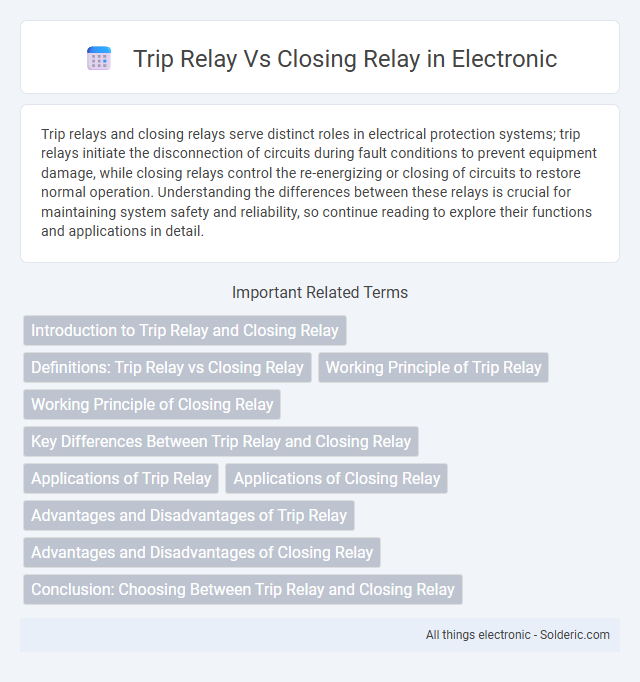Trip relays and closing relays serve distinct roles in electrical protection systems; trip relays initiate the disconnection of circuits during fault conditions to prevent equipment damage, while closing relays control the re-energizing or closing of circuits to restore normal operation. Understanding the differences between these relays is crucial for maintaining system safety and reliability, so continue reading to explore their functions and applications in detail.
Comparison Table
| Feature | Trip Relay | Closing Relay |
|---|---|---|
| Primary Function | Initiates circuit breaker trip to disconnect power | Commands circuit breaker closure to connect power |
| Operation Type | Normally energized; de-energizes to trip | Normally de-energized; energizes to close |
| Use Case | Protects electrical equipment during faults | Engages breaker for normal startup or restoration |
| Response Action | Interrupts current flow immediately | Allows current flow by closing contacts |
| Typical Location | Relay panel or protection system | Relay panel or control circuitry |
| Signal Type | Trip command signal | Close command signal |
Introduction to Trip Relay and Closing Relay
Trip relays are critical safety components in electrical protection systems, designed to disconnect power by triggering circuit breakers during fault conditions. Closing relays facilitate the connection of power by enabling circuit breakers to close and establish a circuit under controlled conditions. Both relays operate in tandem to ensure reliable and safe switching of electrical circuits in power distribution and industrial control systems.
Definitions: Trip Relay vs Closing Relay
A trip relay is an electromechanical or electronic device designed to open circuit breakers and interrupt electrical circuits during fault conditions to prevent equipment damage and ensure system safety. A closing relay, on the other hand, is used to energize and close circuit breakers, enabling the flow of current in a power system. Both relays play crucial roles in protective relaying schemes by controlling the opening and closing operations of circuit breakers in electrical power systems.
Working Principle of Trip Relay
The trip relay operates by receiving an electrical signal from a protective device when a fault is detected, causing it to energize and initiate circuit breaker operation to isolate the faulty section. It functions based on electromagnetic principles, where the relay coil generates a magnetic field that actuates the contact mechanism upon receiving a trip command. This relay ensures rapid disconnection of power to prevent equipment damage and maintain system stability.
Working Principle of Closing Relay
The working principle of a closing relay involves receiving a control signal to energize its coil, which then closes the internal contacts to complete the electrical circuit and allow current flow. Unlike a trip relay that activates to interrupt power during fault conditions, the closing relay ensures the circuit breaker or switchgear closes smoothly to restore power. Your electrical protection system relies on the closing relay to safely and reliably re-energize the circuit when needed.
Key Differences Between Trip Relay and Closing Relay
Trip relays are designed to disconnect electrical circuits by opening contacts during fault conditions, ensuring safety and preventing equipment damage. Closing relays, on the other hand, are responsible for energizing circuits by closing contacts to establish power flow. Understanding your system's reliance on trip vs closing relays enhances protection scheme efficiency and operational control.
Applications of Trip Relay
Trip relays are primarily used in power systems for protection, triggering circuit breakers during fault conditions to prevent damage and ensure safety. They are essential in applications like overload protection, short-circuit interruption, and protection of transformers and generators by initiating a trip signal to isolate faulty sections. Closing relays, in contrast, focus on energizing circuits by closing breakers, while trip relays emphasize disconnecting circuits to protect electrical equipment and maintain system stability.
Applications of Closing Relay
Closing relays are primarily used in circuit breaker control circuits to safely close the breaker contacts, enabling power flow in electrical power systems and protection schemes. These relays ensure the timely and reliable operation of switchgear during normal system energization, fault isolation, and load transfer operations. Their applications include integration in substation automation, motor control centers, and power distribution panels to manage circuit closure under controlled conditions.
Advantages and Disadvantages of Trip Relay
Trip relays provide rapid and reliable circuit interruption during fault conditions, enhancing system protection by isolating only the affected section. They typically offer faster response times than closing relays, reducing the risk of equipment damage and improving grid stability. However, trip relays can cause unnecessary outages if misconfigured or if false trips occur, leading to potential operational disruptions and increased maintenance requirements.
Advantages and Disadvantages of Closing Relay
Closing relays offer advantages such as reliable and fast operation during circuit breaker closing, ensuring proper synchronization and preventing contact welding. However, they can introduce added complexity and cost to the protection scheme and may require regular maintenance to avoid malfunctions. Your system benefits from their precision, but the trade-offs include potential increased downtime and higher initial investment.
Conclusion: Choosing Between Trip Relay and Closing Relay
Selecting between a trip relay and a closing relay depends on the specific function within an electrical protection system. Trip relays are designed to break a circuit during fault conditions, ensuring safety by disconnecting power, while closing relays are used to initiate circuit closure, restoring power flow. Understanding the operational requirements and protection objectives is essential for optimal relay selection in power systems.
trip relay vs closing relay Infographic

 solderic.com
solderic.com